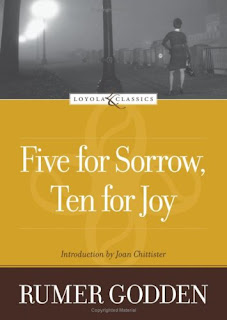 Five for Sorrow, Ten for Joy refers to the total number of decades in the complete rosary—fifteen ... as it used to be before the addition of the five Luminous Mysteries. It is also Rumer Godden’s title for an incredible book about the lives of women, real women—suffering, tainted, fallen women, modern-day Mary Magdalenes. It is fiction and yet it is set in a very real historical context and based on an actual society of sisters, the Sisters of Bethany, many of whom were former prostitutes and prisoners who through Grace and the ministry of other sisters, gave their lives over to God and ministering to the poor, the outcast and the imprisoned.
Five for Sorrow, Ten for Joy refers to the total number of decades in the complete rosary—fifteen ... as it used to be before the addition of the five Luminous Mysteries. It is also Rumer Godden’s title for an incredible book about the lives of women, real women—suffering, tainted, fallen women, modern-day Mary Magdalenes. It is fiction and yet it is set in a very real historical context and based on an actual society of sisters, the Sisters of Bethany, many of whom were former prostitutes and prisoners who through Grace and the ministry of other sisters, gave their lives over to God and ministering to the poor, the outcast and the imprisoned.The story centers around Lise, or Elizabeth Fanshawe, an innocent, young British woman caught up in the liberation of Paris at the end of World War II. Swept away in the delirious debauchery of the time period, Lise finds herself far from home, and totally dependent on a man who runs a brothel when the post-war madness finally ebbs. Oh, and she has the bad fortune of being in love with him as well.
From the beginning of the story we know Lise has a deforming scar on her face and that she has gone from bordello, to years in prison, only to enter a third form of ‘bondage’, a convent. But why? And how is such a transition possible? Who is Vivi? Why has Lucette followed Lise? What is the significance of the rosary to the English Elizabeth, raised Protestant, turned prostitute, then prisoner, finally cloistered nun? These are some of the many questions the story confronts us with as we try to put all the pieces together.
Ms. Godden’s novel is intriguing from start to finish, both as a story and as a commentary on human weaknesses, the longing for God and the never-ending struggle to overcome the self. Two of my favorite passages are these:
'It was a revelation to the aspirants that the sisters, some of them elderly impressive nuns, filled with quiet holiness, should publicly admit their faults. Could Soeur Imelda de Notre Dame, the calm saintly person, really have snapped sharply at anyone? Could Soeur Marie Dominique have lost her temper? “Then do you go on being you until the end? they could have moaned. “Even after all this trying and training?” “Always,” Soeur Théodore would have told them. It was a good thing Compline finished with a prayer to Mary Magdalen: “Intercede and pray without ceasing for us, Marie Magdaleine, you who are most close to our Lord Jesus.”' (page 156)
'“I wish I had your imperturbability,” said Lise.
It was not just a shell; Lise herself could keep her face and voice in control when in reality she was in turnmoil; this was deeper—the nuns were not perturbed over things like this. “When you have seen as much of God’s providence as I have,” said Soeur Raymonde, as any of the nuns would have said, “seen the unfathomable ways in which He works, if you have any sense at all, you learn not to question or to judge—only to trust.”' (page 212)
Prayer and trust: two simple words, two powers actions.
For those familiar with Ms. Godden’s better known novel, In This House of Brede, Five For Sorrow picks up some of the same themes and re-examines them in a new light. However, although both books deal with convent life, they are totally different stories. Which is better? I’d be hard pressed to say. They are both excellent!

No comments:
Post a Comment